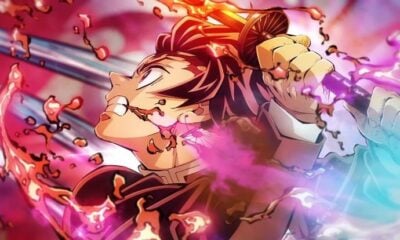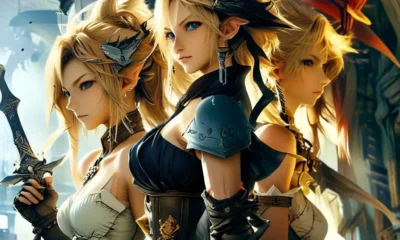Features
Happy 10th Birthday ‘Uncharted: Drake’s Fortune’
Hard as it is for me to believe, Uncharted: Drake’s Fortune celebrates its 10th birthday this month. Ah, it seems like only yesterday I was marveling at the game’s brilliant characters, entertaining story, and incredible visuals.
To mark the occasion, I considered looking back on the series as a whole and discussing some of its defining moments. However, aside from the fact we did just that in the run up to the release of stand-alone spin-off The Lost Legacy, anyone who visits Goomba Stomp regularly will know we’ve covered Uncharted pretty extensively over the last few months.
From indies editor Katrina Lind’s excellent in-depth analysis of Drake’s Fortune, Among Thieves, Drake’s Deception, and A Thief’s End, to site founder Ricky D Fernandes’ effusive tribute to the sheer artistic beauty of Uncharted: The Lost Legacy; editor Mike Worby’s entertaining musings on the series’ future to my own ramblings on the proposed film adaptation.
That being the case, this article instead focuses solely on the progenitor; Uncharted: Drake’s Fortune. Specifically, how a game that, I think we can all agree, is far from perfect mechanically speaking, became one of PlayStation’s most beloved series and a standard bearer for narrative-driven action games in general.
The thing I remember most fondly about Drake’s Fortune (and perhaps every other game in the series, for that matter) is the ridiculously strong cast of characters, led by the now iconic Nathan Drake.
Superbly written and acted, Nate is that perfect balance of roguish explorer and fearless hero, whose razor-sharp tongue, resourcefulness, and surprisingly powerful intellect make him an utterly compelling and likable protagonist; despite the fact that, by the end of the game, his membership to the guild of mass murderers is all but assured.
As engaging as Nate is, however, it’s his interactions with Sully and Elena that make playing Drake’s Fortune so enjoyable.
Nate’s morally questionable mentor, Sully almost immediately establishes himself as one of gaming’s finest supporting characters, with his charming personality, easy-going demeanor, seemingly endless supply of cigars, and penchant for sexual innuendo. I’d even go so far as to say Sully’s at his best in Drake’s Fortune, simply because, knowing little about his past, his loyalty to Nate is, initially, far from certain. It gives his character an additional layer of depth; an edge that, though gradually smoothed away later in the series as it becomes clear he’s earned Nate’s trust, makes the old rogue that much more lovable.
Elena, meanwhile – appearing at a time when most women in video games tended to be depicted as the archetypal damsel in distress (Mario’s Princess Peach, Resi 4’s Ashley etc.) or an overtly sexualized male fantasy (Lara Croft) – was a breath of fresh air. Tough, intelligent, and governed by her own motivations rather than simply following the lead of her male counterpart, Elena was the first in a succession of strong female characters, paving the way for the likes of Chloe Frazer and Nadine Ross.
Admittedly, the villains aren’t particularly memorable by comparison. Neither Gabriel Roman nor Navarro offer much more than standard villain fare in terms of their goals, and thus can’t compete with the likes of A Thief’s End’s Rafe Adler or The Lost Legacy’s Asav. Aside from Eddy Raja, that is.
He wasn’t exactly threatening; as anyone who’s played the game will know, Eddy very much fits the mold of inept yet inexplicably confident and ostentatious, comic relief antagonist. Nevertheless, he was both highly entertaining and an excellent foil to the competent and assured Nathan Drake.
Of course, it helps that these wonderful characters are part of a good old fashioned, Indiana Jones-style adventure story; one that, crucially, has a greater level of complexity than many of the games and films that have tried to capture the spirit of Spielberg’s classic trilogy (Kingdom of the Crystal Skull was a bad dream, right?) since the 1980s.
Nathan Drake himself, for instance, isn’t simply a mercenary looking to make a quick buck selling his ill-gotten treasure on the black market, or a squeaky-clean paragon of virtue seeking to preserve the world’s ancient artifacts for future generations. He’s something in between these two extremes. Nate is certainly hoping to earn some money for his endeavors – which is only fair, given the number of Nazi-zombie-beast hybrids he has to put down over the course of his adventure – but it quickly becomes apparent his main reason for wanting to uncover the secrets of El Dorado is to vindicate and add to the legend of his spurious ancestor, Sir Francis Drake.
Aside from the character of Nate himself, Naughty Dog’s handling of the game’s supernatural elements display a similar level of subtlety and class that’s not always observable in comparable adventure stories. True, vague hints as to the true nature of El Dorado and the forthcoming supernatural twist appear at regular intervals during the course of the game, but it’s not until the last few chapters that these disparate elements come together. As a result, the sense of mystery is preserved for far longer, increasing the effectiveness of the big reveal in chapter 17.
That’s not to say Drake’s Fortune is a flawless example of modern video game storytelling. The similarities between it and the aforementioned Indiana Jones franchise can’t be ignored, while, as stated above, primary antagonist Gabriel Roman’s motivations are pretty unimaginative. Yet, despite the presence of such common elements as Nazis, inexplicably well-preserved and efficacious ancient traps, and a ruthless villain whose only concern is money, Naughty Dog manages to construct a relentlessly compelling narrative that, though not completely original in tone or content, never feels truly derivative either.
Moreover, it provided a solid narrative foundation on which the rest of the series was built. We didn’t pick up Uncharted 2: Among Thieves for its gameplay mechanics, after all; it was to enjoy another one of Nate’s thrilling tales, reunite with some old friends, and enjoy an array of stunning vistas.
Indeed, although it’s easy to forget when comparing the PS3 original with modern titles like Forza Motorsport 7 and Horizon Zero Dawn, Drake’s Fortune was a visually stunning game by 2007’s standards.
My 18-year-old eyes were astounded by the cutting-edge graphics: the character models which, at the time, looked almost photo-realistic; the parade of wonderfully rich, vibrant environments; the incredibly detailed, and distinctive textures that brought these locations to life.
Every new location was a feast for the eyes. From the derelict 16th century Spanish buildings Nate and Elena explore either side of the game’s laborious jet ski sections; to the dark, dank, rubble-strewn corridors of the secret Nazi bunker the pair find themselves trapped in during chapter 18 and, my personal favorite, the lush jungle environments of South America, in which much of the action takes place.
The dazzling color and evocative sound effects, the detailed textures, the interaction between the characters and the terrain; every inch of in-game geography left me in awe of the power of the infant PS3. I vividly remember, for example, how impressed I was when, shortly after witnessing Nate emerge from a waist-deep pool of water for the first time, only the lower half of his body showed signs of recent submersion. Pretty innocuous by modern standards, certainly, but for me, at the time, it symbolized how far the industry had come in just a few short years and how far it would eventually go as video game technology continued to evolve.
Now, I realize that, thus far, I’ve barely mentioned gameplay. In fact, aside from labeling it as unspectacular in the intro, I’ve not mentioned it at all. The combat and parkour mechanics are, I think it’s both fair and accurate to say, the least impressive aspect of the game.
That being said, Drake’s Fortune still offers players plenty of entertaining set-pieces to enjoy, albeit smaller-scale versions of the cinematic sequences that would come to define the series.
Nate’s desperate chase to stop Navarro escaping with El Dorado (spoilers: turns out, rather than an ancient city made of gold, El Dorado is a large, ornately carved golden sarcophagus filled with some sort of nefarious gas) at the game’s climax is a good example. Though not as gloriously over-the-top as the train or cruise ship sequences from Among Thieves and Drake’s Deception respectively, it captures the spirit of both. It’s tense; it’s hectic; it’s interrupted by waves of low-level grunts who don’t seem to appreciate the urgency of the situation; and it culminates in a desperate, last-ditch display of heroism during which Nate disregards his own safety for the greater good.
It’s not the only one, of course. The plane crash that marks the end of chapter 3 bears all the hallmarks of a traditional Uncharted action scene, complete with witty one-liners and a conspicuous lack of serious injuries, while the car chase at the beginning of chapter 7 provides a spot of simple, mindless fun; a welcome distraction from the trickier free running sections and the more tedious shoot outs.
Even the jet ski sequences, bad as they are, had one redeeming quality: they made Naughty Dog understand that the hitherto obligatory video game water level was somewhat passé in 2007 and should thus be removed from all future sequels.
Uncharted: Drake’s Fortune might be the weakest title in the series, but it is nonetheless a fantastic game in its own right, with its immersive story, wonderful cast, and astounding last-gen visuals.
More importantly, it provided the blueprint for the rest of the series, helping Naughty Dog understand how best to refine some of the game’s deficient elements and turn Uncharted into one of the medium’s most popular modern franchises. For this reason alone, Drake’s Fortune earns its place in the video game hall of fame.

-

 Features4 weeks ago
Features4 weeks agoDon’t Watch These 5 Fantasy Anime… Unless You Want to Be Obsessed
-

 Culture4 weeks ago
Culture4 weeks agoMultiplayer Online Gaming Communities Connect Players Across International Borders
-

 Features4 weeks ago
Features4 weeks ago“Even if it’s used a little, it’s fine”: Demon Slayer Star Shrugs Off AI Threat
-

 Features2 weeks ago
Features2 weeks agoBest Cross-Platform Games for PC, PS5, Xbox, and Switch
-

 Game Reviews4 weeks ago
Game Reviews4 weeks agoHow Overcooked! 2 Made Ruining Friendships Fun
-

 Features2 weeks ago
Features2 weeks agoThe End Is Near! Demon Slayer’s Final Arc Trailer Hints at a Battle of Legends
-

 Features3 weeks ago
Features3 weeks ago8 Video Games That Gradually Get Harder
-

 Features2 days ago
Features2 days agoPopular Webtoon Wind Breaker Accused of Plagiarism, Fans Can’t Believe It!
-

 Features3 weeks ago
Features3 weeks agoDon’t Miss This: Tokyo Revengers’ ‘Three Titans’ Arc Is What Fans Have Waited For!
-

 Game Reviews2 weeks ago
Game Reviews2 weeks agoFinal Fantasy VII Rebirth Review: A Worthy Successor?
-

 Game Reviews4 weeks ago
Game Reviews4 weeks agoHow Persona 5 Royal Critiques the Cult of Success
-

 Guides3 weeks ago
Guides3 weeks agoHow to buy games on Steam without a credit card





















